Garganelli Pasta with Romagna Shallots and Guanciale
Pasta with Romagna shallots is a traditional dish in Emilia-Romagna, where delicious Romagna shallots are cultivated. It's easy to make and of course you can use other types of shallots too!
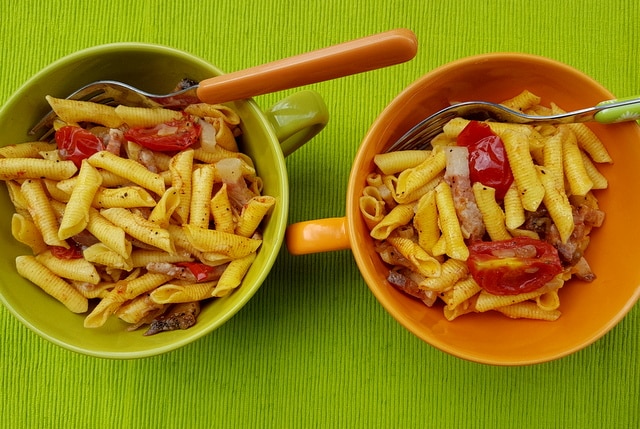
Garganelli con scalogno di Romagna é guanciale.
One of the many things I love about Italy is that every Italian region is well-known for the cultivation, production and processing of certain foods. Some products or crops are particular to only one or two regions (think Gorgonzola cheese). Others are grown or produced mostly only in the South (tomatoes) or the North (risotto rice). A few can be found throughout almost all the Italian peninsula (olive oil).
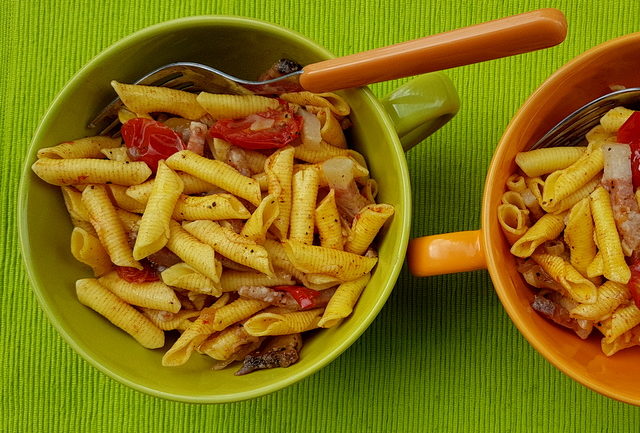
The Emilia-Romagna region produces quite a number of these well-loved foods. Most Italian food lovers will know Parmiggiano Reggiano , balsamic vinegar from Modena or Prosciutto di Parma (Parma ham). But, this region is also famous for vegetables such as asparagus, garlic and shallots. The latter known as Scalogno di Romagna (Romagna shallots) are a type of shallot that is grown in only 3 areas in Emilia-Romagna; in the provinces of Bologna, Forli and Ravenna.
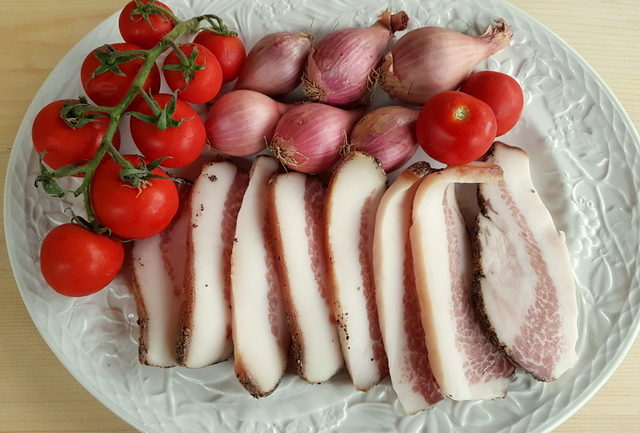
Romagna Shallots.
The Scalogno di Romagna is a pear-shaped shallot that is said to have originated in Palestine. However, shallots have been cultivated in Italy for 5,000 years. Apparently the ancient Romans liked them! The Romagna shallot is a purplish white color. But, it is wrapped in an external skin of different colors,from copper to reddish brown. The taste is definitely particular, stronger and more fragrant than that of an onion and sweeter than garlic. This makes it very versatile on a gastronomic level. In fact, it’s used a lot in the regional cuisine and often included in pasta recipes like this garganelli pasta with Romagna shallots and guanciale (pork cheek/jowl).
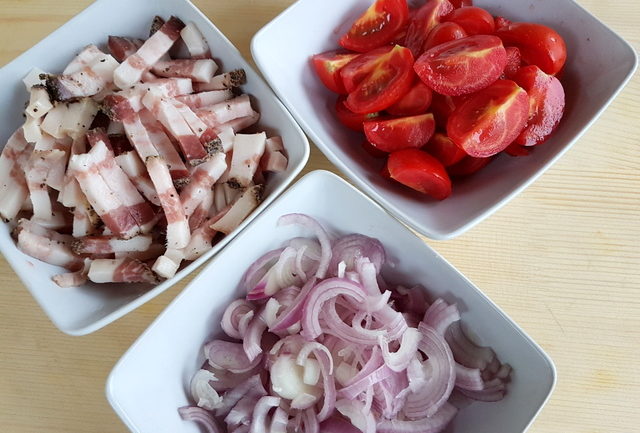
The Pasta.
For this recipe, I used dried garganelli pasta. This is a typical ancient type of pasta from Emilia-Romagna as well. It’s actually one of my favourite types of short egg pasta. You can read about the history of this pretty pasta in my post on garganelli. However, other pasta types are also used with shallot based sauces. You can find these dishes made with flat egg pastas like tagliolini, known as curzul in the local dialect, or tagliatelle another well-known Emilia-Romagna food product.
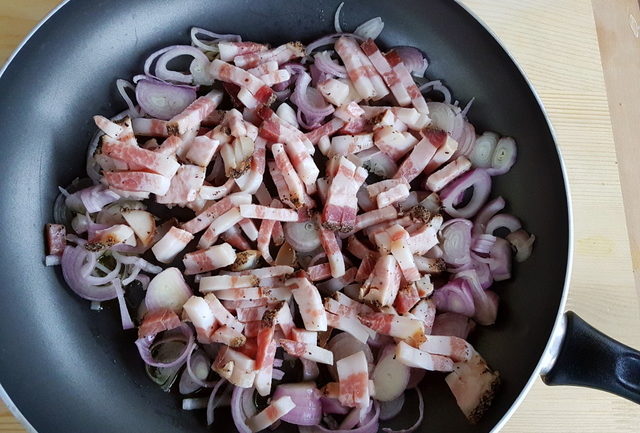
Pasta with Romagna shallots.
There are a few different versions of pasta with Romagna. shallots. However, they are all quite similar. Some include tomatoes, especially if made without meat. In fact, the simplest version is made with just pasta, Romagna shallots and tomatoes! Other versions usually include pancetta or guanciale with or without tomatoes. I used tomatoes and guanciale, which you can substitute with pancetta.
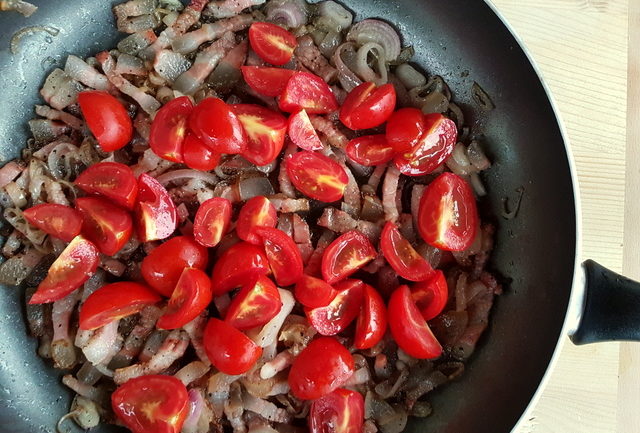
What is the difference between guanciale and pancetta?
You may ask what is the difference between pancetta and guanciale. Firstly, price and availability. Pancetta is usually easier to find and costs less (even here in Italy). But, both are unsmoked cured pork. Pancetta comes from the belly and guanciale from the jowl or cheek. Guanciale definitely has a stronger taste. However, it’s softer and more delicate and the fat often melts away giving more flavour to the dish. Having said that, pancetta is delicious too and better if you want crispy pieces in your dish!
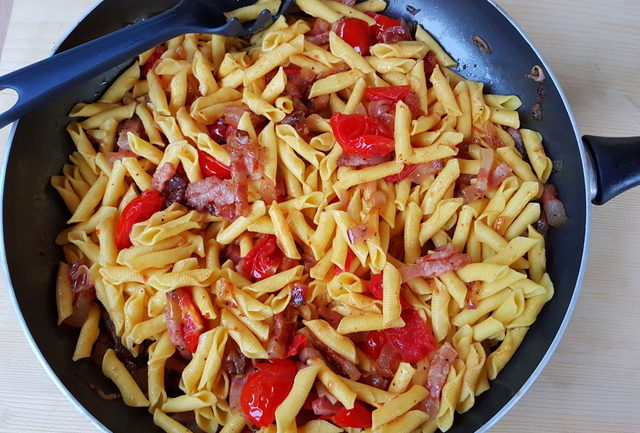
Making this pasta with Romagna shallots.
Although this dish is traditionally made with Romagna shallots you can use other types of shallots. Look for sweet ones. I wouldn’t recommend onions though! Apart from the shallots, tomatoes, and guanciale (pork cheek/jowl) or pancetta all you need is some EVO, white wine, grated Parmesan and, of course, the pasta!
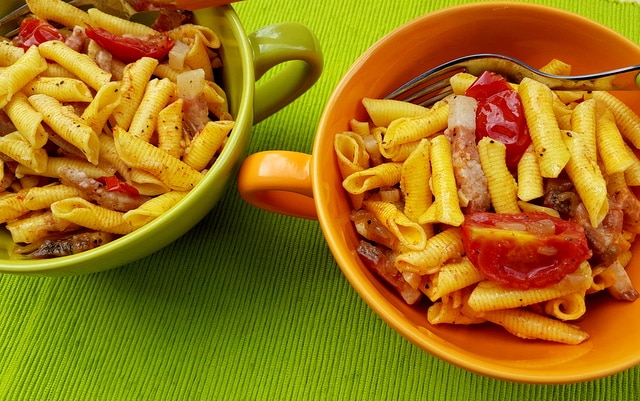
This is another quick and easy recipe that can be made in almost the time it takes to boil the water and cook your pasta. Perfect for weeknights and when you don’t want to spend much time in the kitchen! Like many other simple Italian pasta recipes, garganelli pasta with Romagna shallots and guanciale is incredibly tasty despite the few ingredients. I’m sure you’ll agree once you try it!
If you make this pasta with shallots recipe, I’d love to hear how it turns out and if you liked it. So, please leave a comment here on the blog or on The Pasta Project Facebook page.
Looking forward to hearing from you!
Buon appetito!
Some other pasta recipes from Emilia-Romagna
- Tagliatelle Bolognese
- Lasagne al forno with Bolognese
- Garganelli alla Zingara
- Baked Passatelli with pancetta and pine nuts
- Gramigna with sausage
Save this recipe for later?
If you want to save this recipe for later, you can print it, bookmark this page or save it to Pinterest.
Pin for Later!
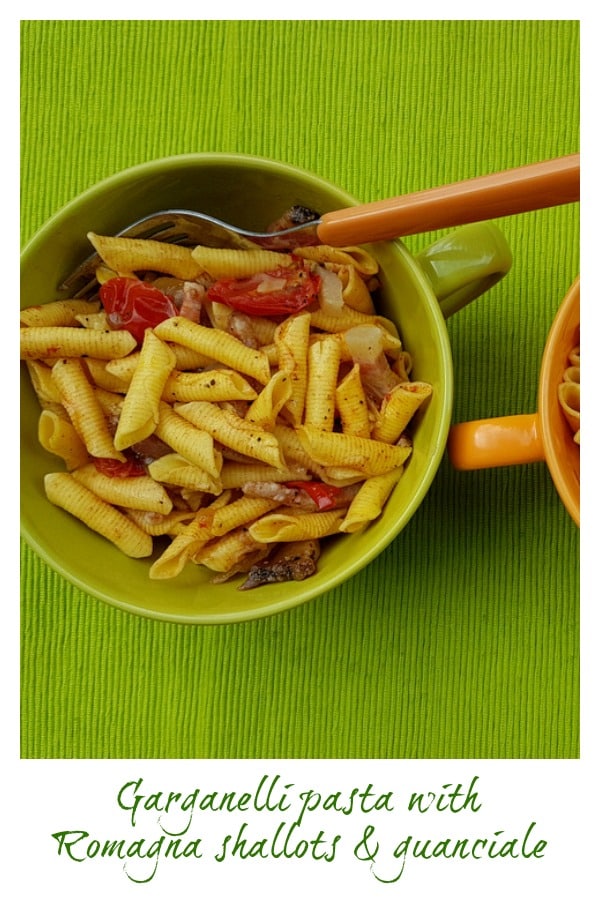
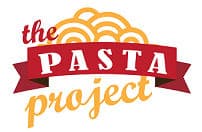

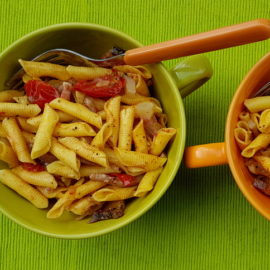
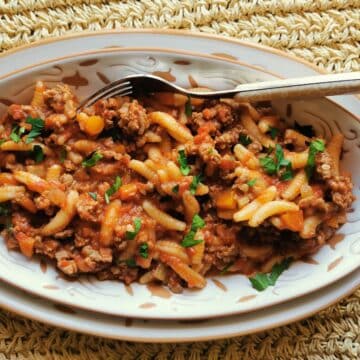
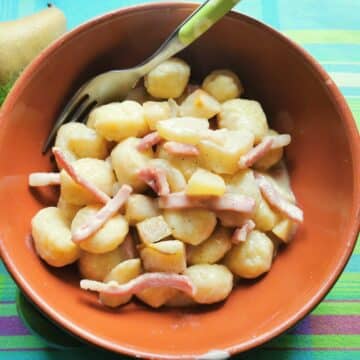

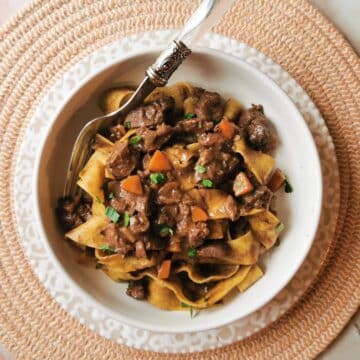
Stephanie Simmons says
Wow this looks incredibly delicious! You never cease to give me pasta inspiration 🙂
Marco says
Da romagnolo, il gaganello non a tutti piace perché nella preparazione la sfoglia in chiusura si sormonta. Quindi in quel punto risulta meno cotta.
Linda says
I've never tried guanciale but I love pancetta so much. And this pasta is another favorite of mine. Just picturing pancetta and shallot in mind already made me happy!
Chef Mireille says
I learn so much when I read your posts - So informative and this is yet another delicious pasta dish I would love to try
Jacqui says
Thank you so much dear Mireille! I'm happy you find my posts interesting and the recipes tempting! Am sure you'll love this dish when you try it!
Julie Running in a Skirt says
You can never go wrong with a tasty pasta dish like this. I love the flavors you combined here- how tasty!
Jacqui says
Grazie Julie! I love the flavours here too. It's a gourmet version of bacon and onions!
Ramona says
Oh my!! This pasta dish, like all your dishes always make me drool. What a perfection this is! A superb idea for one of the busy evenings this week and my kids will be over the moon. Thanks so much for sharing this beautiful pasta dish dear Jacqui xx
Jacqui says
Thank you so much dear Ramona! I'm sure your kids will love this! And yes, perfect weeknight meal because it really doesn't take long to make!
Anna Hettick says
This pasta sounds so good! I love the use of the red onions. I don't cook with red onions enough even though I love the flavor!
Jacqui says
Thanks Anna. Actually these are shallots rather than red onions. They don't taste quite so strong and are sweeter. Although red onions would be an idea too!
April says
I like to see how people use their local produce to make something good and tasty. I like shallots so I am sure I would love this pasta, too! And I would definitely love to travel to Emilia-Romagna!
Jacqui says
Thank you April! Many people say Emilia-Romagna has the best food in Italy! Of course every region has delicious local produce and dishes! And I love that the Italians use locally grown, seasonal ingredients so much in their cooking!
Stine Mari says
I can understand why the Ancient Romans enjoyed the shallot so much! This dish looks so easy, yet filled to the brim with quality produce - yum!
Jacqui says
Grazie dear Stine! Yes this dish is easy to make and, as you say, made with great ingredients. In fact, a lot of Italian recipes are made with just a few ingredients but the quality and taste is so good, the dishes are amazing!
Adriana Lopez Martin says
The bacon or pancetta really make this dish so good I bet it is amazing and the smells on that kitchen must be wonderful while cooking this pasta!
Jacqui says
You are right Adriana, the smell in the kitchen when I was cooking this dish was mouth watering!
Elaine Benoit says
I absolutely adore that pasta!! It's so fun and cute! I love all the flavor combinations you have going here and this looks so delicious!
Jacqui says
Thank so much dear Elaine! This is such a great pasta recipe. Easy to make, super tasty and looks beautiful too! Can't ask for anything more!
PragatiRahulLad says
I am going to definitely try this. My daughter loves pasta and in any form. Your recipe looks interesting and different than what I usually make.
Jacqui says
I'm sure your daughter will love this dish! There are so many great ways to serve pasta and many of them, like this recipe, are pretty easy to make but seriously delicious!
Karyl Henry says
One of my favorite things is to discover fun new pasta shapes! I've never heard of garganelli pasta, but I'll be reading your post about it in a minute...and finding some to buy ASAP
Jacqui says
Garganelli is one of my favourite types of short pasta. It looks so pretty and tastes so good. I'm sure you'll love it Karyl! Hope you find it!
Beth says
I love all of the history you give us of Italian foods and the regions from where they come! This looks like such a delicious and flavorful dish! U wish I had some Romagna shallots, but I will try it with some locally sourced shallots! Thanks for the great recipe!
Jacqui says
Thank you Beth! I'm happy you like my food history and origin info! I think it's great to know more about the food we eat! Romagna shallots aren't easy to find outside of Italy but this dish tastes great with other types of shallot too!
Nayna Kanabar says
Nothing is more welcoming than a hearty bowl of pasta cooked with fresh regional ingredients. This looks so tasty and delicious.
Jacqui says
Thank you Nayna! I agree pasta with fresh regional ingredients really is so enjoyable! Most pasta recipes in Italy originated in the region, town or even village where the main ingredients were or are cultivated or produced! Luckily, today, most of these ingredients are available throughout Italy and abroad so we can enjoy these dishes too!
Patty says
How delicious and comforting these garganelli look! I'd love to try them with guanciale but it's so hard to find in my area, pancetta will do!
Jacqui says
Grazie cara Patty! Garganelli are one of my favourite pasta types! I haven't yet made them myself, but I really want to! Yes, use pancetta. It's good too!
Amanda says
Everything about this sounds so good! I love that you used shallots -- such great flavor. Looking forward to trying this ASAP!
Jacqui says
Thank you dear Amanda! I love using shallots instead of onions. I think they taste yummier! Am sure you'll love this dish!
Nelle Weaver says
My family loves pasta! I can't wait to try this recipe. I have never heard of some of these ingredients, but I love trying new things. Thank you for sharing!
Nelle
Jacqui says
Thanks for your comment Nellie! I'm sure you'll love this dish if you try it. Guanciale and Romagna shallots may not be available where you live but you can make this recipe with other shallots and pancetta. The taste will be slightly different but still delicious!
Kelly Anthony says
As always your pasta recipe sounds amazing. I also like how fresh and fast this recipe is for those busy weeknights.
Jacqui says
Thanks so much Kelly! Yes this is a great weeknight recipe as it comes together fast and has only a few ingredients.
Alisa Infanti says
I have never heard of Guanciale. Love how you often use unique ingredients that I have never heard of before in your recipes. It is fun to learn about new ingredients? When you say it has a bit stronger flavour do you mind helping me understand in what way? Saltier? Gamier?
Jacqui says
Hi Alisa. Guanciale is very popular in Italy but not as available abroad as pancetta. You can, of course, use pancetta instead. I would say guanciale tastes more like pork and yes it is slightly saltier than pancetta. It is actually the main ingredient for well known pasta recipes like carbonara and Amatriciana, but many people use pancetta instead!
Gloria says
I could eat pasta every night of the week. This recipe looks and sounds delicious. The only pasta I don't like is black/squid ink. This would be a crowd pleaser, especially with a nice glass of wine.
Jacqui says
Grazie Gloria! I could also eat pasta every day. I love it too! I quite like black squid ink pasta but it depends on the brand. Not all black pasta is good. In fact the best is fresh and homemade!